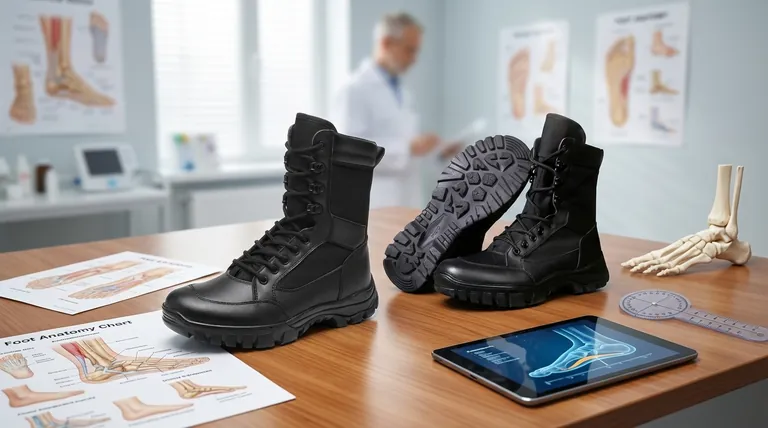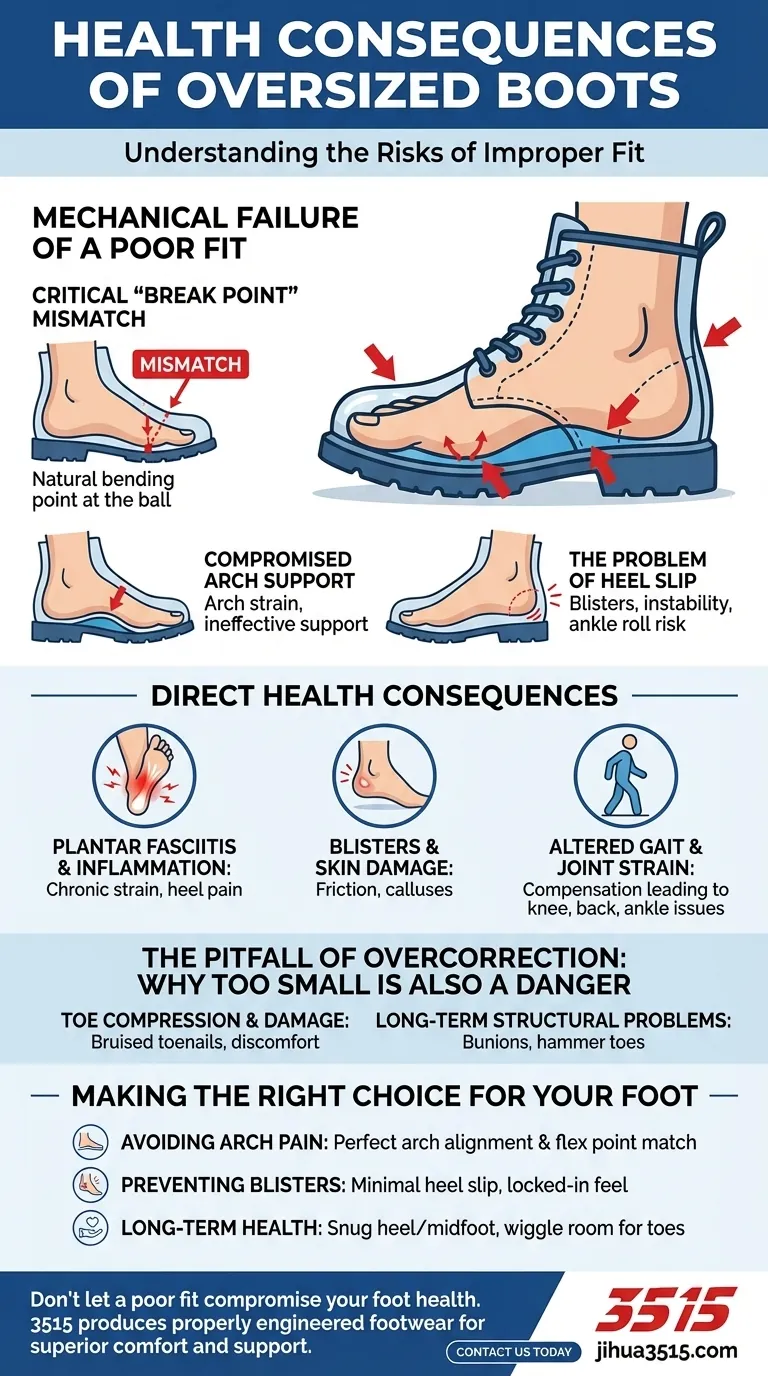Wearing boots that are too big can lead to significant foot problems, primarily because it forces your foot to bend at a point that doesn't align with the boot's intended flex point. This misalignment compromises the built-in arch support, causing your foot to work against the boot's structure, which can result in conditions like plantar fasciitis, inflammation, and flat feet.
The core issue with oversized boots isn't just the extra space; it's the mechanical conflict it creates. When your foot and your boot are out of sync, the boot cannot provide its designed support, leading to instability, friction, and strain on your ligaments and muscles.

The Mechanical Failure of a Poor Fit
A well-designed boot is engineered to work in harmony with the natural movement of your foot. When the size is wrong, that entire system breaks down.
The Critical "Break Point" Mismatch
Every boot has a "break point," which is the line across the forefoot where it is designed to flex as you step.
Your foot has a natural bending point at the ball of your foot. In oversized boots, your foot bends correctly, but the boot's break point is too far forward, causing a mismatch.
Compromised Arch Support
The arch support built into a boot is precisely positioned to cushion and uphold your foot's natural arch.
When the boot is too large, your arch is not sitting in the correct location. This misalignment renders the support ineffective and can lead to arch strain or even the development of flat feet over time.
The Problem of Heel Slip
With too much room, your heel will lift and slide inside the boot with every step. This is known as heel slip.
This constant sliding motion not only causes painful blisters but also creates instability, increasing your risk of an ankle roll or a fall.
Direct Health Consequences
The mechanical failures caused by oversized boots translate directly into painful and chronic health conditions.
Plantar Fasciitis and Inflammation
With the arch unsupported, the plantar fascia—the thick band of tissue running across the bottom of your foot—is put under immense strain.
This chronic strain leads to inflammation and tiny tears in the tissue, resulting in the sharp, stabbing heel pain characteristic of plantar fasciitis.
Blisters and Skin Damage
The friction from heel slip is a primary cause of blisters on the back of the heel. Over time, this can lead to calluses and thickened, damaged skin.
Altered Gait and Joint Strain
To compensate for the poor fit, you may unconsciously alter the way you walk. This unnatural gait can lead to strain not just in your feet but also in your ankles, knees, and even your lower back.
The Pitfall of Overcorrection: Why Too Small is Also a Danger
In an effort to avoid the looseness of a big boot, it can be tempting to choose a size that is too snug. This introduces an entirely different set of problems.
Toe Compression and Damage
Boots that are too small jam your toes against the front of the boot. This pressure can lead to bruised, blackened toenails and significant discomfort, especially when walking downhill.
Long-Term Structural Problems
Constant compression of the forefoot can force your toes into unnatural positions. Over time, this can cause or worsen structural deformities like bunions and hammer toes.
Making the Right Choice for Your Foot
Achieving the correct fit is a balance between securing your foot and giving it enough space to function naturally. Your goal is a boot that feels like an extension of your own body.
- If your primary focus is avoiding arch pain: Ensure the boot's arch aligns perfectly with yours and it flexes exactly where your foot naturally bends.
- If your primary focus is preventing blisters: Confirm there is minimal to no heel slip when you walk, ensuring your heel feels locked in place.
- If your primary focus is long-term health: Seek a snug fit that secures your heel and midfoot while leaving just enough room for your toes to wiggle freely.
Ultimately, the right boot fit is the foundation for your comfort, safety, and long-term foot health.
Summary Table:
| Health Consequence | Primary Cause |
|---|---|
| Plantar Fasciitis & Arch Pain | Misaligned arch support, straining the plantar fascia |
| Blisters & Skin Damage | Heel slip and friction inside the boot |
| Joint Strain & Altered Gait | Instability and compensation when walking |
| Long-Term Foot Deformities | Chronic poor fit leading to structural issues |
Don't let a poor fit compromise your foot health. As a large-scale manufacturer, 3515 produces a comprehensive range of properly engineered footwear for distributors, brand owners, and bulk clients. Our production capabilities ensure every pair offers the correct arch alignment, heel lock, and flex point for superior comfort and support. Contact us today to discuss your footwear needs and provide your customers with boots that protect their well-being.
Visual Guide

Related Products
- Durable High-Ankle Tactical Boots Wholesale Manufacturer for Custom & Bulk Orders
- Safety Footwear Wholesale Manufacturer for Custom OEM/ODM Production
- Durable High-Ankle Tactical Boots for Wholesale & Custom Manufacturing
- Customizable Anti-Smash Safety Boots for Wholesale & Private Label Manufacturing
- Custom Wholesale Leather Safety Boots Direct Factory Manufacturing
People Also Ask
- How do tactical boots and regular shoes differ in cushioning and padding? Unlock the Key to Performance & Protection
- What is the function of the insole in tactical boots? A Guide to Foot Support & Performance
- What are the primary uses of tactical boots? Essential Footwear for Demanding Professionals
- How does the material of tactical boots affect their performance? Choose the Right Material for Your Mission
- What features distinguish a tactical boot from regular boots? Uncover the Key Design Differences



















